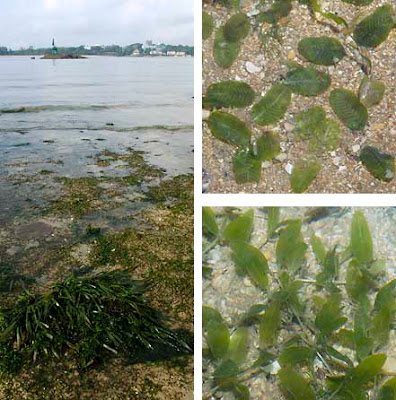 Chek Jawa was January's shore of the month! As we round up the articles on Chek Jawa, it seems appropriate to consider the fate of Chek Jawa.
Chek Jawa was January's shore of the month! As we round up the articles on Chek Jawa, it seems appropriate to consider the fate of Chek Jawa.While death by burial has been postponed, is Chek Jawa free of threats?
Thoughtless fun on Chek Jawa?
Although the water between Pulau Sekudu and Chek Jawa are now restricted, there appears to be little compliance. Canoeists and sailing boats continue to land on Pulau Sekudu, and use Chek Jawa. Jetskis zoom up and down, while in the waters nearby fishing, drift netting as well as laying of fish traps continue. More photos on the reddot blog.

Litter on Chek Jawa
Marine debris (i.e., litter on the shore) continues to impact Chek Jawa.
 Litter seen include styrofoam bits, plastic beverage bottles, used noodle containers, snack packaging, even a tube of sunscreen. Could some of these be tossed by inconsiderate users of the Chek Jawa boardwalk? A photo of a styrofoam noodle container with left over noodles in it suggests this could be so.
Litter seen include styrofoam bits, plastic beverage bottles, used noodle containers, snack packaging, even a tube of sunscreen. Could some of these be tossed by inconsiderate users of the Chek Jawa boardwalk? A photo of a styrofoam noodle container with left over noodles in it suggests this could be so.Abandoned drift nets kill until they are removed
Abandoned fishing nets remain a threat to marine life on Chek Jawa. Although many volunteer cleanups have been conducted at Chek Jawa, there is a constant inflow of abandoned nets as well as accumulation of old debris.
During one visit in Aug 07, volunteers came across an abandoned net full of living horseshoe crabs that were recently trapped in the net.

In Jan 08, a few volunteers visited to specifically deal with the abandoned fish net problem. They immediately tackled the nets entangled among mangrove tree roots. These nets trap crabs, prawns, small fishes and other animals that naturally shelter among such roots at high tide.
 Out on the shores were more nets. This is one of the large accumulations of nets, overlooking Pulau Sekudu.
Out on the shores were more nets. This is one of the large accumulations of nets, overlooking Pulau Sekudu. The net seemed to have entangled and killed this large eel-tail catfish.
The net seemed to have entangled and killed this large eel-tail catfish. The nets were massive.
The nets were massive. Removal was hard going as the ground was soft.
Removal was hard going as the ground was soft. The best efforts of the small team resulted in quite a pile being dragged out during the short low tide window. Still, it was just a tiny proportion of the nets that are still out there.
The best efforts of the small team resulted in quite a pile being dragged out during the short low tide window. Still, it was just a tiny proportion of the nets that are still out there.
What is the future of Chek Jawa? in the longer term
Reclamation has been deferred for 10 years from Jan 2002 and assurances have been given that Chek Jawa will not be reclaimed so long as it is not needed.
This is the plan that was published in 1991, in the book The Next Lap.
 It shows in industry (in pink) and high density housing (in orange) for Pulau Ubin and Pulau Tekong with an MRT line (in red) from the mainland to both islands. As Singapore's population grows and more land is needed, this might indeed, eventually be the fate of the two islands and Chek Jawa.
It shows in industry (in pink) and high density housing (in orange) for Pulau Ubin and Pulau Tekong with an MRT line (in red) from the mainland to both islands. As Singapore's population grows and more land is needed, this might indeed, eventually be the fate of the two islands and Chek Jawa.As it is, with the recent reclamation, Pulau Tekong already has the shape depicted in the plan.

So come, visit Chek Jawa and see it for yourself while you can!
Better yet, make a difference and volunteer for Chek Jawa. Volunteers are always sorely needed. Be a volunteer guide to share this wonderful place with as many people as possible while we can.
Or come help us clean up Chek Jawa so that marine life can thrive there.
Visiting Chek Jawa
More about Chek Jawa's ecosystems on the wildsingapore website
Information for visitors to Chek Jawa how to get there, what to do, on the wildsingapore website
Guided intertidal walks on Chek Jawa by the Ubin NParks volunteers
Guided Chek Jawa boardwalk tours by the Naked Hermit Crabs
Blogs about Chek Jawa visitors, volunteers and more from the wildsingapore google reader
Volunteering for Chek Jawa
Chek Jawa guide with Ubin NParks
Internationational Coastal Cleanup Singapore
The Naked Hermit Crabs
Other IYOR articles on Chek Jawa
Pulau Sekudu: a part of Chek Jawa
Chek Jawa: Death and Life in 2007
Chek Jawa: The Boardwalk
Chek Jawa: After Deferment of Reclamation
Old Chek Jawa
Chek Jawa: Jewel of the northern shores





































